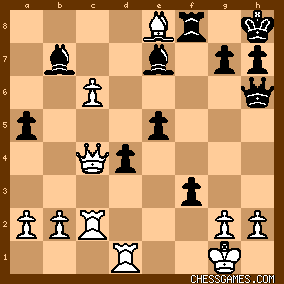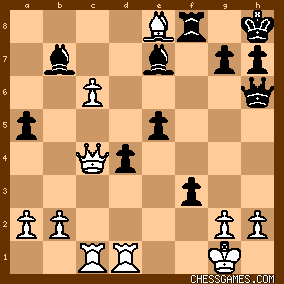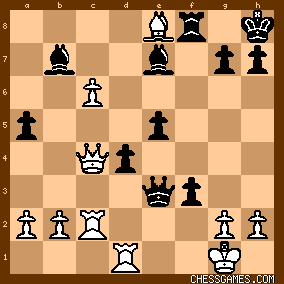|
< Earlier Kibitzing · PAGE 6 OF 7 ·
Later Kibitzing> |
| Jun-03-16 | | The Kings Domain: Nice, pretty complex game by the two leading masters of their day, capped by the famous pawn march. Chessgames should create a page for the landmark De la Bourdonnais-McDonnell match in the Tournament Index section of the site. I'm surprised it still hasn't been done yet. |
|
| Jul-30-16 | | Tal1949: I still do not get it. McDonnell plays 25.Rc2 and does not follow it up with 26. Rf2. Instead he moves the King and weakens his position dramatically. What was he thinking? |
|
| Jul-30-16 | | Ultra: <The Kings Domain: Nice, pretty complex game by the two leading masters of their day, capped by the famous pawn march. Chessgames should create a page for the landmark De la Bourdonnais-McDonnell match in the Tournament Index section of the site. I'm surprised it still hasn't been done yet.> A motion has been advanced and I second it! |
|
| Oct-28-16 | | clement41: Astonishing early Sveshnikov! Def deserves more fame |
|
| May-08-17 | | MichaelAndrewLo: A wonderful analysis
https://www.youtube.com/watch?v=xkG... |
|
Nov-12-17
 | | ChessCoachClark: <morphynoman2: In "Kasparov Teaches Chess", the former World Champion says about the final position of this game: "This position, where the small pawns were victorious over the enemy, was so surprising that it seemed like a fairy tale and I was unable to live without chess after seeing it. I have admired this position ever since". (Kasparov was then 6 years old)">
I have read this book and found this game intriguing as well as a motivator to beginners. Nunn and abhor reliance upon games before 1999, but true gems must be promoted. Yes! |
|
Oct-22-18
 | | 0ZeR0: In my estimation this is the most ideal game ever played. I never tire of it. |
|
| Jan-30-19 | | Damenlaeuferbauer: The first immortal game in the history of chess. The modern dynamic of black's play is astounishing - this could be a game, which is played by two GMs/IMs today in an open or robin-round tournament all over the world (of course not a super-elite event). Every chess player in past and present would be very proud to play such a game from the black side of the board. |
|
| Feb-02-19 | | Albanius: I don't think a modern GM would play 5 Nxc6, losing a net tempo (three N moves to one plus the pawn capture) while giving B a extra center P.
The eventual punishment more than fit the latter positional crime. |
|
| Feb-03-19 | | Damenlaeuferbauer: <Albanius> In principle you are right, but in fact the two GMs Bozidar Ivanovic (Yugoslavia/Montenegro) and Ratmir Kholmov (Soviet Union / Russia) [both rated over Elo 2500] played 5. Nxc6. Just for the records, after 1. e4,c5 2. Nf3,Nc6 3. d4,cxd4 4. Nxd4,Nf6 5. Nc3,d6 6. Bc4,Qb6 later WC Anatoly Karpov played 7. Nxc6 (A. Karpov - Leonid Stein, 39th Soviet Championship Leningrad 1971, 1-0). In my only tournament game with the Sicilian Kalashnikov 1993, White also played 5. Nxc6 followed by Nc3, Bc4 and Bg5, I was unable to win with the black pieces and finally lucky with a draw. |
|
| Sep-15-19 | | RandomVisitor: After 21...Kh8

click for larger viewOthers have suggested the improvement 22.Nd6
After 22.Nd6 Bxd6 23.Ba4 Qxc5 24.Qxc5 Bxc5

click for larger viewStockfish_19082608_x64_modern:
<50/93 1:20:25 -0.35 25.Rxc5> Re7 26.f4 exf4 27.Rxd4 g6 28.Rxf4 Rd8 29.Rc1 Re2 30.Rc2 Re1+ 31.Rf1 Re4 32.Rc7 Bd5 33.b3 Rd4 34.Bc6 Bxc6 35.Rxc6 Rd2 36.Rf2 Rxf2 37.Kxf2 Rd2+ 38.Kg3 Rxa2 39.Rc7 a4 40.bxa4 Rxa4 41.Kf3 h5 42.g3 Kg8 43.Rd7 Re4 44.Rc7 Kf8 45.h4 Re7 46.Rc4 Kg7 47.Kf4 Kh6 48.Kf3 Re1 49.Kf2 Rd1 50.Kg2 Kg7 51.Ra4 49/83 1:20:25 -0.65 25.Bxe8 Bb6 26.Bc6 Ba6 27.Kh1 g6 28.h3 Rf6 29.Ba8 Be2 30.Rd2 Bb5 31.b3 Rf8 32.Bb7 Rb8 33.a4 Be8 34.Bd5 Rd8 35.Bb7 Bf7 36.Rc6 Ba7 37.Ra6 Bc5 38.Rd3 Bb4 39.Rb6 Rd7 40.g4 Re7 41.gxf5 gxf5 42.Ba6 Kg7 43.f4 e4 44.Rxb4 exd3 45.Rxd4 Re4 46.Rxd3 Rb4 47.Kg2 Bxb3 48.Kg3 Bxa4 49.Rd5 Bc6 50.Rd6 Rb3+ 51.Kf2 Rb2+ 52.Kg3 Rg2+ 53.Kh4 Be4 54.Rd7+ Kf6 55.Bc4 |
|
Sep-30-19
 | | GrahamClayton: <Phony Benoni>
"Black has accomplished nothing but giving up queens on three successive moves. An interesting achivement, but otherwise it's hasta la vista." <Phony Benoni>
The two white rooks capture on e1, and the two black pawns capture and promote on e1, all in the space of just two moves. |
|
| Oct-01-19 | | spingo: <Ultra: <The Kings Domain: ...
Chessgames should create a page for the landmark De la Bourdonnais-McDonnell match in the Tournament Index section of the site. I'm surprised it still hasn't been done yet.> A motion has been advanced and I second it!> The trouble is, they did not play one match, they played about 6 matches totaling about 87 games. That makes it a lot of work, especially as resolving correct dates would be tedious. |
|
| Jun-18-20 | | MordimerChess: There were couple of ways for McDonnel to draw the game, for example:
25. Rf1 Qe3+ 26. Kh1 fxg2+ 27. Kxg2 Rxe8 28. cxb7= or move later:
26. Rf2 Ba6 27. Qxa6 Bc5 28. Qf1 d32 9. Rxd3 Qg5 30. Kh1 Bxf2 31. Rxf3 Rxf3 32. gxf3 Bb6= Interesting is that 25. Rc2 was losing but only to mentioned above 25...Ba6!! My detailed video analysis: https://youtu.be/hM1aQ81Tp5o Only for fans of classics, take your time :D |
|
Nov-08-20
 | | kingscrusher: For some weird reason as of 8th Nov 2020, when I do "view PGN" on a desktop , I get: "
[Event "London m4; HCL 18"]
["London ENG" site]
[Date "1834. ??. ??"]
[EventDate "?"]
[Round "?"]
[Result "0-1"]
[White "Alexander McDonnell"]
[Black "Louis Charles Mahe De La Bourdonnais"]
[ECO "B32"]
[WhiteElo "?"]
[BlackElo "?"]
[PlyCount "74"]
1.e4 c5 2.Nf3 Nc6 3.d4 cxd4 4.Nxd4 e5 5.Nxc6 bxc6 6.Bc4 Nf6
7.Bg5 Be7 8.Qe2 d5 9.Bxf6 Bxf6 10.Bb3 OO 11.OO a5 12.exd5
cxd5 13.Rd1 d4 14.c4 Qb6 15.Bc2 Bb7 16.Nd2 Rae8 17.Ne4 Bd8
18.c5 Qc6 19.f3 Be7 20.Rac1 f5 21.Qc4 + Kh8 22.Ba4 Qh6 23.Bxe8
fxe4 24.c6 exf3 25.Rc2 Qe3 + 26.Kh1 Bc8 27.Bd7 f2 28.Rf1 d3
29.Rc3 Bxd7 30.cxd7 e4 31.Qc8 Bd8 32.Qc4 Qe1 33.Rc1 d2 34.Qc5
Kg8 35.Rd1 e3 36.Qc3 Qxd1 37.Rxd1 e2 0-1
" Which shows 34.Qc5 Kg8
instead of 34.Qc5 Rg8
Does anyone else see this issue?!
Also it is OO instead of O-O in the above PGN
However on my TV web browser, it is fine. Strange. |
|
Nov-08-20
 | | jessicafischerqueen:
<Tryfon> Good to see you around here so often again! I hope you are well. I am having much fun playing correspondence tournaments on https://www.chessworld.net/ thank you for hosting! Yes I am getting the same bug from my desktop computer as you report here. I know that the new technicians are currently beta testing some code having to do with the pgns, so I hope this glitch is only temporary. Your report on this page clearly identifies a pgn bug though and is of general interest to the administration. I will email one of the techs now and make sure he is aware of this new development. Thank you! |
|
Nov-08-20
 | | kingscrusher: Jessica thanks
I should also point out the " +" should not have a preceding space before the "+" sign. Cheers, Tryfon |
|
| Jul-19-22 | | LoveThatJoker: Game twenty from the 1869 book "Chess Brilliants" by John Odin Howard Taylor. LTJ |
|
| Jan-12-23 | | generror: Probably the most famous game of this first proto-World Championship, this one has been included in many, many "greatest games ever" lists. Once again, the opening is interesting. La Bourdonnais frequently used the Sicilian against McDonnell, and McDonnell hat begun by answering <2.f4> (called "McDonnell Defense", although it was already used in J Wilson vs G Atwood, 1801). After initial success, he scored five losses in a row with it, before changing to <2.Nf3> in the 4th match, with which so far he had scored +1=2-0. After this game, he tried <3.Bc4> once, lost, and then reverted to <2.f4>, with mixed results. It's pretty much the same story with his defense against La Bourdonnais' Queen's Gambit; Morphy had already noted that McDonnell's stubbornness in openings was one reason he lost the majority of games. In the following moves, La Bourdonnais plays quite accurately (<4...e5>), while McDonnell plays a couple of weak moves, notably <5.Bxc6> (instead of <5.Bg5>) and <7.Bg5?!>, to which Stockfish suggested <7...Qa5+!?> which indeed seems to win at least a pawn. <9.Bxf6?!> needlessly gives up the bishop pair, and after <12.exd5? cxd5> (D), Black is significantly better (<12...a4! 13.Bc4 cxd5 14.Bb5 Bb7> would have gained a tempo). 
click for larger viewFrom here on, the play from both sides if pretty patchy, with many inaccurate moves from both sides. <14.c4?> gives black a nice passed d-pawn, but La Bourdonnais doesn't prevent it from advancing, and after a series of weak moves by La Bourdonnais, we get to the critical position after move <21...Kh8>: 
click for larger viewHere McDonnell plays <21.Ba4?>, and, despite winning the exchange, Stockfish evaluates this position as about -2, while after <22.Nd6 Bxd6 23.Ba4! Qxc5 24.Qxc5 Bxc5 25.Bxe8 Bb6 (Rxe8?? 26.Rxc5) 26.Bc6 Ba6 27.Kh1> -- also winning the exchange -- Black's advantage is only minimal. It took me a while to see why, Stockfish is often very unwilling to show its reasoning (hm, maybe because it hasn't got any reasoning; it just has numbers). |
|
| Jan-12-23 | | generror: What makes <21.Ba4?> so bad is that, after <25.Rc2> (D), White has the completely crazy and awesome <25...Ba6!!>, and after <26.Qxa6 (26.Qb3?? Be2!) e4! 27.gxf3 d3 28.Rg2 exf3 29.Rg3 (29.Rf2?? Bc5) Bh4>, White just can't save his bishop and/or his rook AND prevent one of the pawns from promoting.
click for larger viewThe best he can do is <30.Qa7 Bxg3 31.hxg3 Rxe8 32.Qf2 Qxc6 33.Rxd3 Rf8> (D), and Stockfish says it's about -3.0, but to me this looks like an easy win for black: Get the g-pawn to g4, then advance the h-pawn with the king, being careful not to allow perpetual checks, and once the h-pawn is at h4, the world is your oyster. 
click for larger viewBack to the game. After <25...Qe3+?>, White could have actually completely equalized by playing <26.Rf2 Ba8 27.Bd7> -- and that little c-pawn suddenly has become just as dangerous as Black's phalanx! Tragically for McDonnell, his <26.Kh1??> gets his opponent out of any trouble, and although now misses winning the rook and the game immediately by <26...d3! 27.Qxd3 Qxd3 28.Rxd3 f2 29.Rxf2 Rxf2>, there now just is no way to stop his pawn avalanche. After <28...d3> (D), <29.Bxc8> would have given White slim chances of survival, but <29.Rc3?> makes his situation really hopeless. 
click for larger viewAfter <34.Qc4?>, the position is actually a forced mate in 16, but the two play on until they reach a sufficiently picturesque position for McDonnell, that incorrigible aesthete, to resign in. Although this game has the typical inaccuracies of chess before generations of master practice began to discover sound positional principles, you just can't *not* admire this creativity and recklessness with which these two minds battled each other on the chessboard, and how fearless they went into incredibly complex positions that even today would be far above anyone's capabilities to handle. And although some of their games are genuinely sucky (especially McDonnell seemed to be quite clueless if he hasn't the attack on the opponent king), this *is* truly great chess. Very different from modern chess, but great nonetheless. |
|
| Jan-12-23 | | generror: PS. Has any commenter of this game ever noted that awesome move <25...Ba6!!> instead of <25...Qe3+>? |
|
| Jan-13-23 | | Gregor Samsa Mendel: <generror>--McDonnell vs La Bourdonnais, 1834 |
|
| Jan-13-23 | | generror: Very nice! Not even Kasparov mentions it, nor any another annotator I could dig up. <Magorian> gives the move a "!?", which was also my initial reaction, but after spending some time analyzing it, I realized just what a winner that move is and decided to give it a "!!". |
|
| Jul-04-23 | | DanLanglois: 1.e4 c5 2.Nf3 Nc6 3.d4 cxd4 4.Nxd4 e5
5.Nxc6? Better is 5. Nb5!
5...bxc6 6.Bc4 Nf6
7.Bg5? Better is 7. Nc3!
7...Be7 8.Qe2 d5
9.Bxf6? Better is 9. exd5!
9...Bxf6 10.Bb3 O-O 11.O-O a5
12.exd5? Better is 12. Rd1! White gets into big trouble. 12...cxd5? Better is first 12...a4! 13. Bc4 cxd5 14. Rd1 (doesn't work) Bb7
15. Bxd5 Bxd5 16. Nc3 Black has 16...Ra5! And thus, keeps the piece. 13.Rd1
13...d4? Sadly, the idea of 13...Bb7 doesn't land with force here,
White can play 15. Bxd5. But still there is better than this, as Black
has 13...Ba6!
14.c4? Better is 14. Nd2! White is in big trouble again. 14...Qb6? Black lets White off the hook again, maybe a little bit. Better is 14...Qc7! 15.Bc2? Better is 15. Nd2!
15...Bb7? Better is 15...g6!
16.Nd2
16...Rae8? Better is 16...g6!
17.Ne4? Better is 17. Rab1!
17...Bd8? Best is 17..Be7!
18.c5 Qc6 19.f3 Be7 20.Rac1
20...f5? Better is Ba6!
21.Qc4+ Kh8:

click for larger view22.Ba4? Better is 22. Nd6! Bd6 23. Ba4. After all, the knight is hanging on e4. 22...Qh6:

click for larger view23.Bxe8 fxe4 24.c6 exf3:

click for larger viewWhite's best is 25. Rf1!
Instead, White played 25. Rc2?

click for larger viewWhite is in big trouble. Black can play 25...Ba6! That's a
sacrifice, after 26. Qxa6 Black plays 26...e4, which sets up ...d3. But Black played 25...Qe3+??

click for larger viewNo advantage with this move. White can play 26. Rf2! But White played 26.Kh1??

click for larger viewBlack can play 26...d3!
However, Black played 26...Bc8?! Still pretty good. So yes, White is in big trouble. 27.Bd7

click for larger view27...f2?! There are multiple ideas for Black, here. Simply 27...d3 28. Qxd3 Qxd3 29. Rxd3 f2 30. Rxf2 Rxf2 might be prudent. 
click for larger view28.Rf1 d3 29. Rc3? Bxd7 30.cxd7? e4 31.Qc8 Bd8? (31...Rg8) 32.Qc4? Qe1 33.Rc1 d2 34.Qc5? Rg8 35.Rd1? e3: 
click for larger viewA quibble here, is that White lasts longest if he plays 36. h3, although he doesn't. 36.Qc3 this gives Black something faster than the immediate ...e2. 36... Qxd1 37.Rxd1 e2

click for larger view0-1 |
|
| May-11-24 | | Saniyat24: 3 little goblins creeping me to death...that cracked me up...LOL...! |
|
 |
 |
|
< Earlier Kibitzing · PAGE 6 OF 7 ·
Later Kibitzing> |
|
|
|





